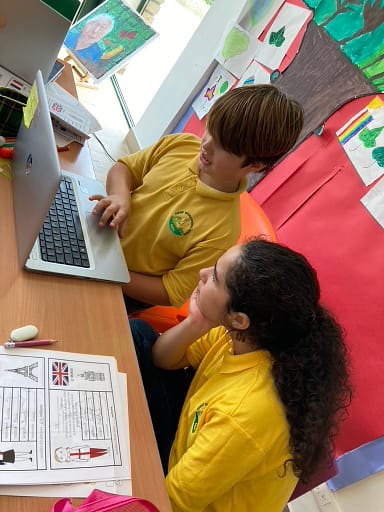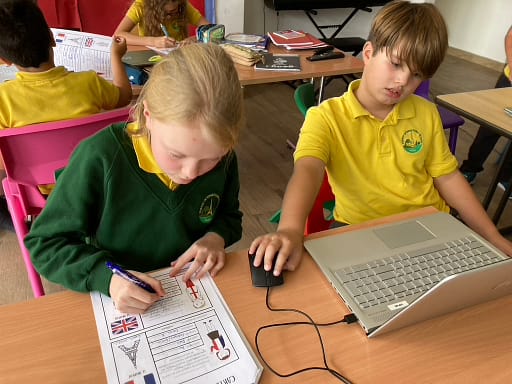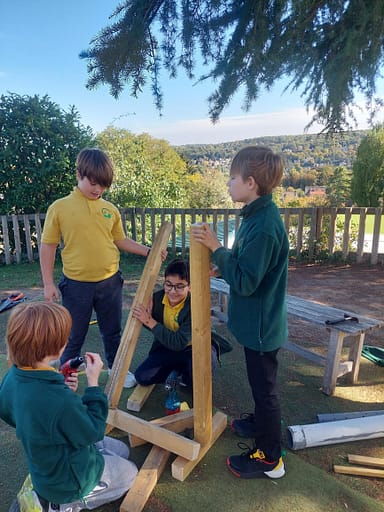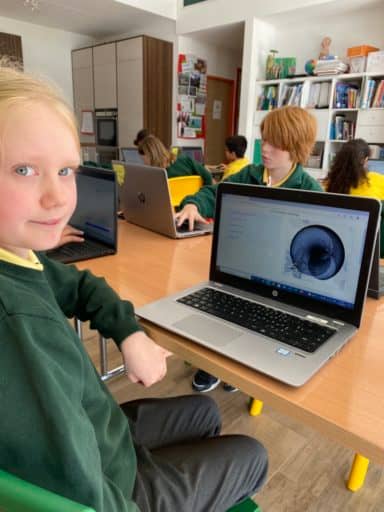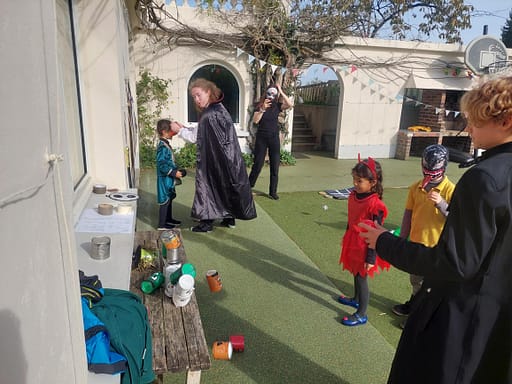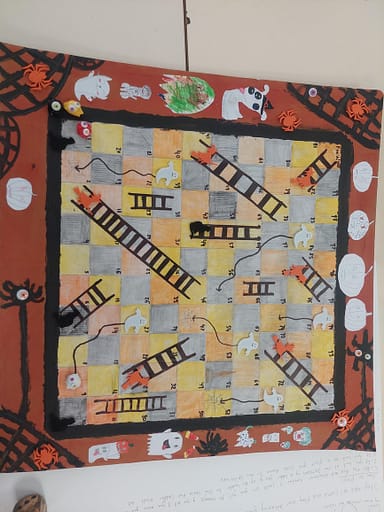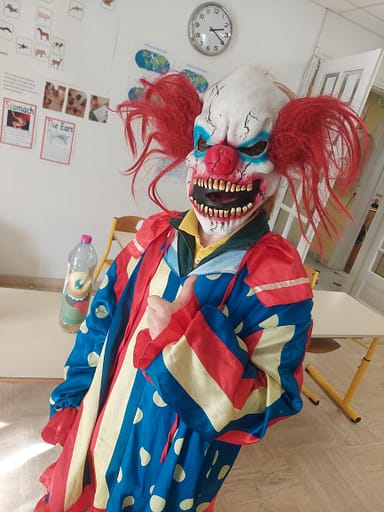English
Elm class began the term learning about different genres of writing and their respective characteristics. We began the year with this unit to remind the class that not all reading and writing is the same and that good readers approach each genre a little bit differently in order to comprehend the reading in the best way.
This short unit was followed by Elements of Fiction and Short Stories. The class broke story plots down into six different stages, from Exposition to Resolution, and turned their hands to creating their own story outlines following the same stages. They read several short stories, Hearts and Hands by O. Henry, The Pedestrian by Ray Bradbury and The Hitchhiker by Roald Dahl. The class paid particular attention to characterisation, examining the various techniques writers use to create characters and reveal their personalities.





French
Beginners Group with Joanna
The students have had a busy first term revising (for those who began learning French last year) & learning new vocabulary. We are beginning to grasp the basics of what may seem the rather daunting French grammar/conjugation rules in a fun, yet educational way with lots of visual prompts, class conversations as well as with the ‘Zig Zag+2 Méthode de Français’ workbooks/audio guide and through learning poems/songs with our classmates.

The method we use in class to learn French in a fun & educational way. 


Sorting out vocabulary about the past, present and future into the right categories. 

Working together as a team. 
The final result. 
A board game ‘tout sur moi’ (all about me). 
A game to learn the days of the week/months/seasons. 
Poems on display that the students learned about autumn. 
Intermediate Group with Christine
This year students will strengthen their knowledge of French and improve it with the help of « Adosphere »,their new learning book. We will follow the lives of 8 teenage characters (4 girls and 4 boys) who present their daily life (tastes, emotions, worries) in relation to others and to the surrounding world. In each module there is a specific dialogue with one of the characters with topic-related vocabulary, grammar and conjugation. Some additional exercises are given out to consolidate learning. At the end of each module students will create their own questions (based on what was learned) & add questions to the ZigZag game. The students learned two poems this term ( about school and autumn) enabling them to develop oral skills and vocabulary.
Just like last year, we do the daily Calendar exercise. This daily routine helps students to cover a large scope of topics like the date, the weather, the seasons, moods and activities. Each student should be able to ask questions to the others and receive answers. This is an interactive exercise in which all students of all levels partake.
After the holidays, the next module, with the character Manon, will cover the topic of the Home and we will also discover the Castles in France. We will also talk about Christmas to close this time period.
Advanced Group with Marie
Durant cette période, les élèves ont étudié plusieurs notions:
en grammaire: la phrase et ses caractéristiques (formes et types), la phrase simple et complexe (1 seul ou plusieurs verbes), la phrase verbale et a-verbale, le nom et le groupe nominal, les déterminants, les pronoms, l’adjectif, les mots invariables ainsi que la nature/classe grammaticale des mots.
en conjugaison: les temps du passé, présent et futur, le verbe et son infinitif, les verbes d’action et les verbes d’état, le présent de l’indicatif de tous les verbes, l’imparfait des auxiliaires être et avoir ainsi que des verbes du 1er groupe.
en vocabulaire: le champ lexical du mythe et du conte autour du monstre, utilisation du dictionnaire.
en orthographe: 3 dictées ont été effectuées.
en mémorisation: apprentissage de 2 poésies “Ponctuation” et “Automne”
en littérature: 1 roman a été lu et étudié:
- Histoire à la courte paille de Gianni Rodari

5 évaluations ont eu lieu depuis le début de la rentrée:
- 1 évaluation diagnostique qui permet d’établir le niveau de l’élève et de voir ainsi quelles compétences il a acquises, et celles qui sont à consolider.
- 4 évaluations portant sur la phrase, le présent de tous les verbes, la nature/classe grammaticale des mots, l’adjectif épithète ou attribut et l’imparfait.
French IMYC with Marie
Cette première période avait pour thème “Identité et Communauté”
Dans un premier temps, les élèves devaient dessiner un de leur camarade (tiré au sort) et les autres devaient deviner qui c’était. Puis, nous avons étudié le monde pour ensuite converger vers l’analyse de l’Europe (d’un point de vue géographique mais aussi politique).


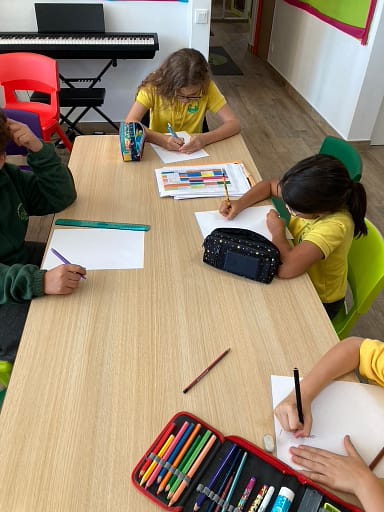

Au travers de leurs recherches, les enfants ont découvert et ont appris pourquoi et comment s’était formée l’Union Européenne.
Nous avons abordé plusieurs points:
– les différents continents et pays du monde et la recherche des caractéristiques de plusieurs pays (capitale, monnaie, langue parlée…)
– la formation de l’Europe (son histoire)
– les 27 pays qui la constituent
– les symboles de l’Europe
– les traités qui l’ont fait évoluer
– la politique de l’Europe
Par groupe de 3, ils ont travaillé sur un aspect de l’Europe. Ils ont élaboré des “posters” qui ont été assemblés à la fin. Puis ils ont répondu à un quizz “Jouons avec l’Europe”.
Ensuite, nous avons analysé certains monuments européens les plus connus avec un petit film projeté en cours:
Enfin, nous avons aussi appris 3 chansons: Dire bonjour c’est joli, L’oiseau et l’enfant, We can make a difference.
Spanish
SEPTEMBER-OCTOBER
LINGUISTIC AND LEXICAL OBJECTIVES
-Greeting, introducing oneself and saying goodbye.
-The alphabet and the pronunciation of sounds: RR, J, CH, LL, Ñ
-Ask for and say the first name and age.
-Numbers and their use: date and age
-Time: days, months, seasons.
CULTURAL OBJECTIVES
Family names. Why do Spaniards and some Hispanic Americans have two surnames?
Song of the San Fermines to learn the months.
Día de Muertos: a festival full of joy!






*GRAMMAR: The subject personal pronouns, gender and number, the article. The present tense of the regular indicative but ONLY the first three persons
The aim is to make the children want to talk, so the class should revolve around their world and their interests, they should need to talk and the Spanish class should be the time when they can express themselves most freely…in Spanish. During my studies I wrote my dissertation on “The affective value of languages” at the age of these children it is important that the first contact with an “artificially” learned language is positive and natural, that is why grammar remains a tool in the course but never an objective.
HOLIDAY WORK: Reverse classroom. After the holidays we will work on the family to prepare the ground the children should watch the film “COCO” in Spanish with English subtitles to answer the questions given.
NOVEMBER-DECEMBER
LINGUISTIC AND LEXICAL OBJECTIVES
-To talk about our tastes and habits
-Talking about food
-Animals and character.
-Family members.
CULTURAL OBJECTIVES
-Hispanic family, Christmas and its traditions. The Three Wise Men.
Project: Los Reyes Magos
Mathematics
In Number: Fractions/Decimals and Percentages
During this unit, our Elms worked on finding percentages of amounts and fractions of numbers. The children practised finding the equivalent fractions by multiplying/dividing the numerator and denominator by the same number and then converted mixed numbers and improper fractions. The children can confidently carry out four basic operations with fractions and know how to find the LCD (Lowest Common Denominator) or when they need to simplify their fraction. We solved one-step and two-step problems involving numbers, money and measures including fractions, decimals and percentages and know what strategies to use while converting between them. The children worked on choosing and using appropriate calculation strategies while solving word problems.

Elm class students identified Positive and Negative numbers and then followed the BIDMAS rule to find the order of operation. We worked on finding and remembering Prime and Square Numbers and then used them while solving various problems with powers and roots. We
Science
Elm students kicked off their first term by digging and planting different kinds of seeds and testing the effect of water, Carbone dioxide, and light on plants photosynthesis.








We had the chance to explore human body systems structures and functions through a very engaging projects in which students cut a life size human body organs and built up a skeleton, digestive ,respiratory and circulatory system.







At the end of the term, Elm class explored cell mysteries and had the chance to find out about the microscopic cell organelles through a plant cell-making project. They identified each organelle function by making a structure-function finding pocket.












HISTORY
The Elm class focused on the way people lived in the late Medieval age. They have looked at the difference between the village and the town in the late Middle Ages, learning the similarities and the differences between the two contexts. The Elm class concluded the term by looking at the arrival of the Black Death in Walsham, a British Medieval village. They engaged in a role play based on the work of the historians, studying the different ways in which people reacted to the arrival of the plague.
Geography
This term, Elm built on their previous study of mapping, learning about Ordnance Survey maps. The class learnt how these maps were introduced in the late 1700s to map Britain for the military. The class learnt how to read grid coordinates, ‘Eastings and Northings’ and to read the topographical information provided on the maps, from the contour lines that show an area’s height above sea level and whether it is flat or hilly, to the blue tourist information and the symbols for roads, footpaths and boundaries. The class then moved on to latitude and longitude, extending their understanding of grid lines to those used to identify where places are on Earth.




Design and Technology
Elms investigated different products and discussed their design features and then clearly highlighted the purpose that they serve.
Linked to our learning in Science, based on plants, Elms came up with their individual prototypes of different products that make gardeners or pet owners life easier. Creative sparks were flying while sketching our very own self-watering gardening system, automatic food dispenser for dogs and self-flying paper planes. The children were then encouraged to come up with a design that reduces our carbon footprint and tackles the fire wood shortage conundrum.
The children were asked to think about the different materials that they needed to use for their specific designs. They all came up with very different group ideas and were encouraged to share and discuss with each other before agreeing on the final version of their product.
Oak and Cedar came to help as well!


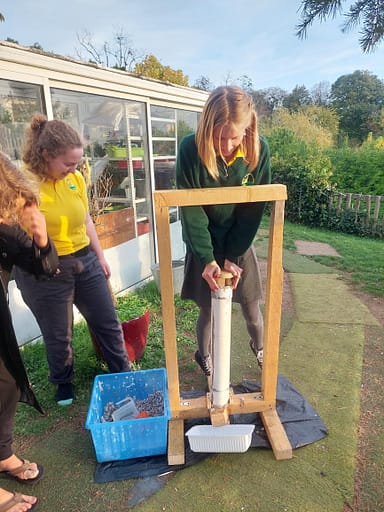




We estimated, measured, re-measured, sorted, cut and hammered different materials and now are very proud of our achievement. In order to accomplish our Eco Logs Press, we learnt how to use a variety of carpentry tools safely.
Woodworking projects are extremely important for developing children’s creative and critical thinking skills. Through these projects, not only do children get to handle and smell the wood but also learn how to use the different carpentry tools. They develop their mathematical thinking, broaden their scientific knowledge and, most importantly, acquire a ‘can do’ mindset.
ART
The Elm class worked on the construction of their self-portrait, getting inspired by the work of the Renaissance painter Giuseppe Arcimboldo. The students realised a naturalistic self-portrait and they transformed it into a collage done by using autumn natural materials tha they found in the forest.
ICT
Elm students have been applying their problem-solving and logical skills to a programming platform that has shown them how to move in any direction, set a heading, create different shapes, how to make a list and insert a background by using shortcuts and a multiple set of commands. They worked hard to understand and apply what they learnt to their projects. Bravo!
Global Perspectives
Elm students looked at the various ways people use energy, at national ang global level. They worked in groups on different topics related to the use of energy, looking at solar energy, energy and pollution, uses of electricity and medical applications of nuclear energy. Each group presented their work by creating poster and digital presentations.
Drama Workshops
The Elm class worked on the use of body, looking at miming and freeze frames as way to represent feelings and actions. They also constructed tableaux portraying crowded scenes and stories, working on the use of proxemics and props.
Creative Writing Workshops

Elm students created their own personalised writer’s notebooks, using their imagination to create colourful cover pages. They have worked on a writing stimulus based on a real experience – the school’s canoeing trip – to write either a fictional story or a journal focused on what they have done during the excursion. The class ended the term by setting individualised writing goals and looking at the role of mentor texts when writing their own stories.
Forest Exploration and Mushroom hunting




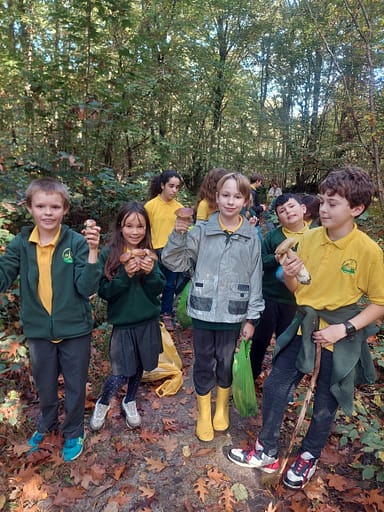



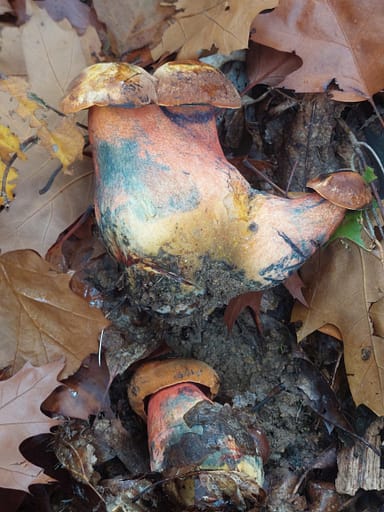




Canoeing Trip
Oak, Elm and Cedar classes canoeing on the tranquil waters of “the little arm of the Seine”.
Located between Vétheuil and Haute-Isle in the Vexin Regional Nature Park, this spectacular and secluded section of the Seine was a source of inspiration for many impressionist painters.



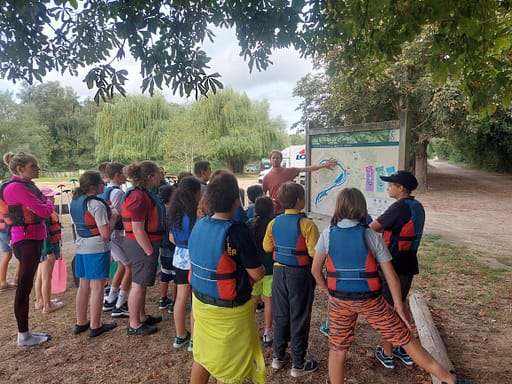



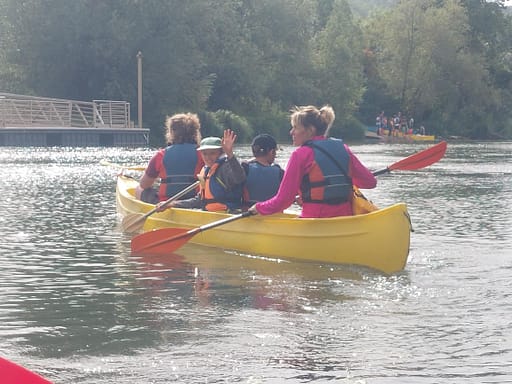

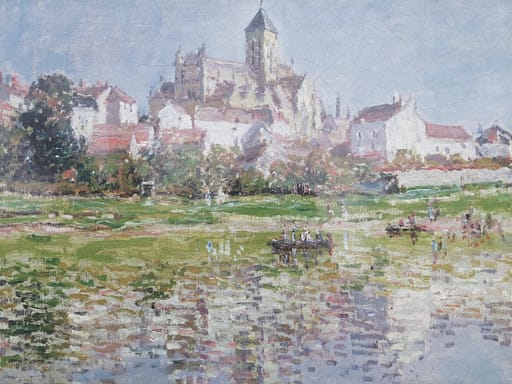

Halloween Celebration
Oak, Elm and Cedar students creatively collaborated together while designing their exciting Halloween activities for the rest of the school.
Enjoy your holiday, Elms!
FISP Team









